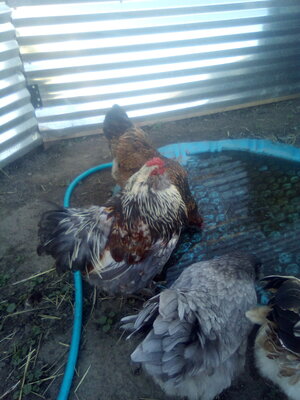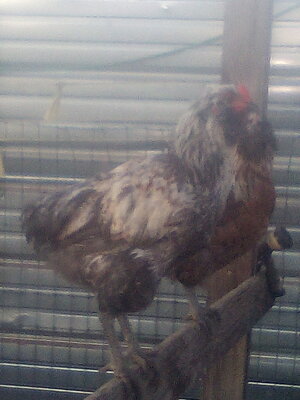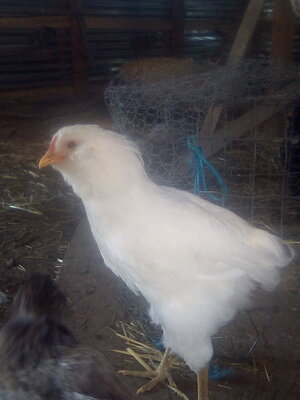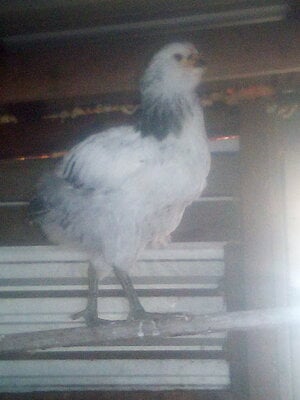- Jan 13, 2013
- 55
- 11
- 99
Hi all. I am an older backyard flock breeder of many years with little knowledge of proper genetic breeding to any standard other than my own, so I will appreciate any response, especially from geneticists, breeders or even if you just think they are cute! I have bred generations of my private flock of non-standard mixed Ameraucana Easter Eggers for fun and table. I am curious whether genes from their original Aracauna lineage could affect or consistently present themselves in a new manner resembling the source lineage but is obviously not authentic to it?
LOL! This "rear end" effect (which makes me call them Puff Tails) first appeared in one cockerel about five years back. I thought it sort of cute and went with what Mother Nature was offering by keeping him and breeding him back to the flock. Over the last few years slowly in the males this "rear end" has developed to be a fairly consistent presentation and seems to slowly be shortening the girls tails also. Some chicks will "age out" of it and grow short tails as their teenage hormones surge however, many others stay mostly without into adulthood. As can be seen in the pics the boys still develop neck hackles and the typical narrow sword feathers just in front of where the large curving sickle feathers should grow. Of those I have inspected, most seem to still have tail vertebrae (parsons nose) but smaller than average. They seem to have no problems breeding. All adult cocks and coming of age teenage cockerels have high sexually activity and definitely make contact with the hens. Proven by the high percentage of developing embryos when I candle seven day eggs. I have heard of the genetic mutation of roosters being "hen tailed" but my understanding and internet research has shown that they still do have tail feathers, and resembles a hen’s tail - no large curving sickle type feathers.
Hard to get good pics when they keep moving but below are a few of the boys and how they look. First pic is a twelve month old cock (named Hey Hey from the Moana movie since he looks so funny), second is a seven month old son, third a five month old son? And four a three month old son? Hard for me to tell at times. All are from different hens and none have been "feather plucked". Nothing really there to pluck! LOL!
Is this physical presentation a throwback genetically to the source lineage, an extreme form of hen type feathering in males like an extreme appendage alteration of the skin genes similar to crested chickens or, something else? I know overall chicken genetics are very convoluted and an EE’s genetics even more so LOL! But if anyone can contribute I would appreciate it.
Thank you for your time and responses,
The Curious Lynx




LOL! This "rear end" effect (which makes me call them Puff Tails) first appeared in one cockerel about five years back. I thought it sort of cute and went with what Mother Nature was offering by keeping him and breeding him back to the flock. Over the last few years slowly in the males this "rear end" has developed to be a fairly consistent presentation and seems to slowly be shortening the girls tails also. Some chicks will "age out" of it and grow short tails as their teenage hormones surge however, many others stay mostly without into adulthood. As can be seen in the pics the boys still develop neck hackles and the typical narrow sword feathers just in front of where the large curving sickle feathers should grow. Of those I have inspected, most seem to still have tail vertebrae (parsons nose) but smaller than average. They seem to have no problems breeding. All adult cocks and coming of age teenage cockerels have high sexually activity and definitely make contact with the hens. Proven by the high percentage of developing embryos when I candle seven day eggs. I have heard of the genetic mutation of roosters being "hen tailed" but my understanding and internet research has shown that they still do have tail feathers, and resembles a hen’s tail - no large curving sickle type feathers.
Hard to get good pics when they keep moving but below are a few of the boys and how they look. First pic is a twelve month old cock (named Hey Hey from the Moana movie since he looks so funny), second is a seven month old son, third a five month old son? And four a three month old son? Hard for me to tell at times. All are from different hens and none have been "feather plucked". Nothing really there to pluck! LOL!
Is this physical presentation a throwback genetically to the source lineage, an extreme form of hen type feathering in males like an extreme appendage alteration of the skin genes similar to crested chickens or, something else? I know overall chicken genetics are very convoluted and an EE’s genetics even more so LOL! But if anyone can contribute I would appreciate it.
Thank you for your time and responses,
The Curious Lynx






